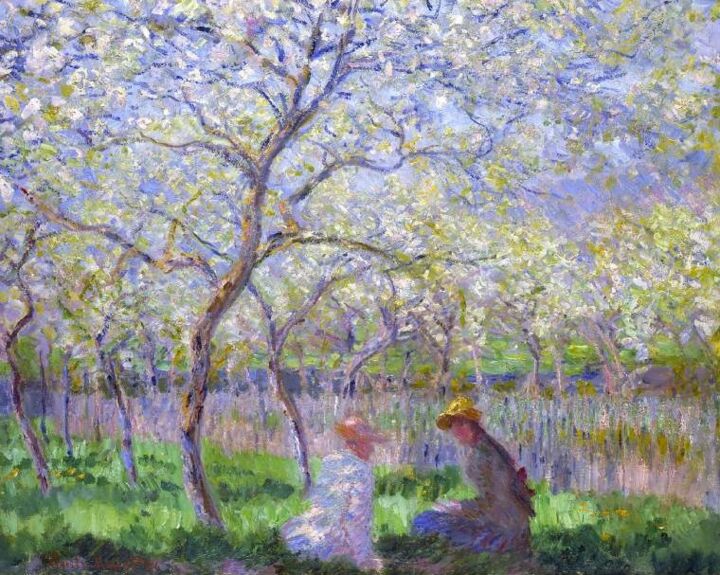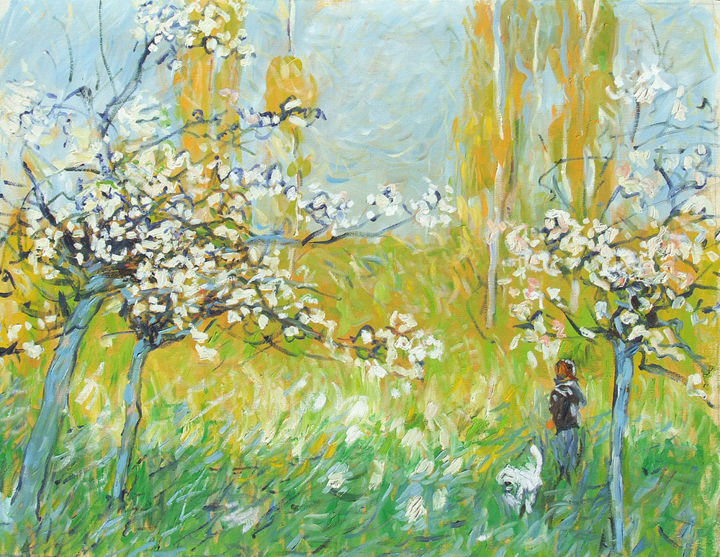 Andrey Berekelia, Spring morning, 2020. Oil on canvas, 65 x 75 cm.
Andrey Berekelia, Spring morning, 2020. Oil on canvas, 65 x 75 cm.
Impressionism: the origins of a new landscape painting
Between 1800 and 1900, landscape painting underwent a remarkable transformation: from a minor genre rooted in the classical tradition, rich in courtly references and strongly idealized, it became a new form of artistic experimentation, which, eschewing illusionism, emphasized the naturalness of the purest pictorial act. But to what was this epochal change due? First of all, the innovations brought during the Thirties of the nineteenth century, by the group of painters of Barbizon (France), artists who rejected the prevailing idealization of landscape, in order to prefer a naturalistic observation of reality. For example, in order to achieve this goal, the exponents of the Barbizon left their studios forever, in order to draw directly from nature, or "en plein air". This was only the beginning of the new landscape painting, which found its greatest expression and fame in the work of the next generation of French painters, called Impressionists.
 Guy Dessapt, Printemps à Central Park, New York, 2021. Oil / acrylic on linen canvas, 60 x 73 cm.
Guy Dessapt, Printemps à Central Park, New York, 2021. Oil / acrylic on linen canvas, 60 x 73 cm.
 Mayako Dessapt, Spring at Saint-Tropez, 2021. Acrylic on linen canvas, 20 x 20 cm.
Mayako Dessapt, Spring at Saint-Tropez, 2021. Acrylic on linen canvas, 20 x 20 cm.
Impressionism and Landscape
The invention of collapsible metal tubes for oil paints in 1841 and, around the same time, the expansion of French railway lines, allowed the Impressionists to move into the countryside, which, immortalized with greater ease and immediacy, soon became among the most iconic subjects of their work. But what are the distinctive features of this landscape painting? It is undoubtedly known the importance that the Impressionists gave to the direct observation of the natural datum, in order to generate works including a palpable speed and spontaneity of execution, with the aim of capturing every minimum change of time, seasons and hours of the day, within the natural context. As far as the painting technique is concerned, instead, they used to refer to some rules:
- use short, thick strokes of bright color, in order to get a quick impression of the essence of the subject;
- avoid the use of black color, in fact, grays and dark tones were obtained by mixing together contrasting shades;
- apply the colors one next to the other, avoiding mixing and therefore exploiting the principle of simultaneous contrast, to make the color appear more vivid;
- make the shadows with the blue of the sky, giving a sense of freshness previously not represented in painting;
- refer to the innovations of recent photographic art, capturing fleeting moments, or true snapshots of time.
Finally, the landscape research of the Impressionists was not only naturalistic in intent, but also documentary, since they wanted to be able to immortalize with authenticity a world that, due to the prevailing modernization, was now inexorably changing.
 Monet, Springtime, 1886. Oil on canvas, 64.8 x 80.6 cm. Cambridge: Fitzwilliam Museum.
Monet, Springtime, 1886. Oil on canvas, 64.8 x 80.6 cm. Cambridge: Fitzwilliam Museum.
Monet and the Spring: Springtime (1886)
As mentioned before, the landscapes of impressionists wanted to capture the changes of time, such as, for example, those brought by the succession of seasons, in order to maximize the natural and atmospheric peculiarities. An example of this is the painting dedicated to springtime by Claude Monet, Springtime of 1886. This masterpiece, which captures the beautiful season in the French town of Giverny, wanted to emphasize the brightness of spring colors, which have been merged in a wise chromatic range. In fact, the white, blue and green of the landscape overlap, sometimes blurring, within a perspective space that, dilated in the background, aims to amplify the suggestion and the beauty of nature in bloom. In reality, however, the charm of the work is largely conferred also by the brushstrokes tending to the very pery color, which delicately reverberate on the trunks of the trees, on the women's clothes and on other details. The whole chromaticism of the work, however, is marked by blurred contours that, like a light aura, give the atmosphere a dreamy air. Finally, the two figures sitting on the lawn, painted with rapid brushstrokes, highlight the greater attention that the Impressionist master paid to the natural world. In fact, this approach is precisely aimed at fusing the human component within the prevalent naturalistic investigation.
Contemporary Impressionism and Spring
 Abid Khan, Lovely moments. Oil on fabric, 5,1 x 91,4 cm.
Abid Khan, Lovely moments. Oil on fabric, 5,1 x 91,4 cm.
 Patrick Marie, Finally spring, 2002. Oil on canvas, 50 x 65 cm.
Patrick Marie, Finally spring, 2002. Oil on canvas, 50 x 65 cm.
Patrick Marie: Finally spring
Many other great Impressionist masters, such as Renoir, Sisley and Morisot, depicted spring, a season rich in natural attractions and luminous hues, which also attracted the attention of contemporary artists, such as Artmajeur's ones. Precisely the latter have innovatively reinterpreted the lesson of the French masters, always referring to the style and poetic vision of the iconic current of the second half of the nineteenth century. An example of what has been said is the painting Finally spring, by the artist of Artmajeur, Patrick Marie, where, as in the works of Monet and Sisley, the human figure, executed with rapid strokes of the brush, blends into nature, giving life to a work whose main purpose is to celebrate the atmosphere of the beautiful season. In reality, however, unlike Monet's masterpiece, in Marie's painting we find a composition with less amalgamated colors, where emerge details of the darker tones, such as, for example, the branches of trees. Therefore, it is evident how every contemporary reference to an artistic current of the past, always involves new and unprecedented interpretations, which help to enrich a great and immortal tradition.
 Anh Huy Tran, Spring Market, 2020. Acrylic/oil on canvas, 100 x 80 cm.
Anh Huy Tran, Spring Market, 2020. Acrylic/oil on canvas, 100 x 80 cm.
Anh Huy Tran: Spring Market
Another typical subject with which Impressionism has immortalized spring are flower markets, as evidenced by Flower Market, a painting of 1895 by Childe Hassam, an American exponent of the movement. This tradition continues in contemporary art with the oil painting by the artist from Armajeur, Anh Huy Tran, entitled Spring Market, where the subject of the market is innovatively re-proposed through an unprecedented shot from above, which still makes it possible to identify the lively splashes of color that make up the flowers and characters. Finally, the work of the artist from Artmajeur, marked by a rich and intense chromatism, is more intense than its American "counterpart".
 Garri Arzumanyan, Spring Landscape 06, 2021. Oil on canvas, 40 x 31 cm.
Garri Arzumanyan, Spring Landscape 06, 2021. Oil on canvas, 40 x 31 cm.
Garri Arzumanyan: Spring Landscape 06
A contemporary interpretation of spring that, while having stylistic elements derived from impressionism, turns out to be unrelated and independent, is the painting by Garri Arzumanyan, entitled Spring Landscape. This work is made unique by the particular interpretation of Impressionist color patches, the framing from above, and the contemporary subject matter. In fact, the painting, which shows spring as seen from the window of a modern house, immortalizes some trees, which appear as the only natural survivors, within a now cemented reality. Therefore, probably, the work, like Impressionist art in its time, wanted to show the world with realism and fidelity, shunning an illusory idealization.


 Olimpia Gaia Martinelli
Olimpia Gaia Martinelli



































